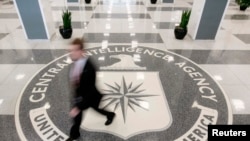WASHINGTON -- A U.S. Senate report released December 9 details the CIA’s harsh interrogation practices used against suspected terrorists at secret detention facilities throughout the world.
While the full 6,000-page report remains classified, the redacted 500-plus-page executive summary made public reveals brutal violence toward detainees held by the CIA in the years following the September 11, 2001, terrorist attacks on the United States.
Here are the key findings of the report, based on a five-year investigation conducted by the U.S. Senate Intelligence Committee.
‘Not Effective’
The report concludes that the CIA’s "Rendition, Detention and Interrogation" program did not yield effective intelligence to prevent terrorist attacks.
Investigators reviewed 20 prominent cases touted by the CIA as successes resulting from so-called “enhanced interrogation techniques” on detainees. In some of these cases, there was no relationship between the interrogation and the information the CIA obtained from a detainee, the report concludes.
In other cases, intelligence that the CIA claimed to have extracted from a detainee was available from other sources or obtained prior to subjecting the suspect to "enhanced interrogation," investigators found.
‘Brutal’ And Misleading
Techniques used under the interrogation program, which U.S. President George W. Bush authorized in 2002, were more “far more brutal” than the CIA represented to policymakers or the public, the report asserts.
As evidence, investigators recount numerous instances of violent and disturbing treatment that detainees were subjected to during questioning.
"Interrogation techniques such as slaps and ‘wallings’ [slamming detainees against a wall] were used in combination, frequently concurrent with sleep deprivation and nudity," the report states. Detainees were also deprived of sleep for up to 180 hours, usually in "standing or stress positions."
At least five detainees were subject to rectal feeding without any medical need, with personnel injecting pureed food into detainees' rectums. One detainee, Majid Khan, engaged in acts of self-harm following this practice, the investigation revealed.
The report says records uncovered by investigators contradict the CIA's claims that it used "an open, non-threatening approach" or that interrogations began with the "least coercive technique possible."
Missing Detainees
CIA officials in public and in classified settings have said that the agency held fewer than 100 detainees under its supervision during the time the program was in place.
The report states, however, that 119 “known detainees were in CIA custody during the life of the program.” Moreover, inadequate record-keeping makes it impossible to conclude the precise number of detainees that were held by the CIA under the program, according to the report. At least 26 were wrongfully held, investigators added.
One CIA station chief in a country not identified in the report told the agency’s headquarters that the CIA was "holding a number of detainees about whom" it knew "very little," describing the discovery of this situation "unsettling."
Physical Harm And Death
Waterboarding, a technique that simulates drowning and that Obama administration officials have said is torture, caused physical harm to detainees, the report concluded.
The CIA's first detainee under the program, Abu Zubaydah, became "completely unresponsive, with bubbles rising through his open, full mouth" during one waterboarding session but was later revived.
The CIA also instructed personnel that the interrogation of Zubaydah should take "precedence" over medical care, resulting in the deterioration of a bullet wound, investigators found.
At least five detainees suffered hallucinations after being subjected to sleep deprivation. In at least two cases, the CIA nonetheless continued to use the technique on the detainees, according to the report.
At a CIA detention facility code-named COBALT, which a senior interrogator described as a "dungeon," the lack of heat likely contributed to the death of a detainee, the report states. The CIA placed a junior officer with no relevant experience in charge of the facility, and the detainee died in 2002 after being partially nude and chained to a concrete floor, it says.
Detainees were subject to techniques that had not been authorized by the Department of Justice or CIA headquarters, and personnel were rarely held accountable, according to the report.
The CIA routinely subjected detainees to nudity and dietary manipulation, while several others were subjected to abdominal slaps and doused with cold water prior to mid-2004, investigators concluded. The Department of Justice had not authorized any of these techniques.
At least 17 detainees were subjected to interrogation methods not authorized by CIA headquarters. In more cases these techniques were employed against detainees by interrogators who were not authorized to use them, according to the report. Corrective action was "rarely" taken against interrogators, it added.
The CIA inspector-general identified wrongdoing in two cases in which the agency’s senior leadership overruled its recommendations, the report said. The CIA declined to take action against an officer involved in the death of the detainee at the COBALT facility because headquarters had been "motivated to extract any and all operational information" from him, it added.
Damaged Image
The CIA interrogation program also damaged the United States' standing in the world, the report concludes.
The program complicated alliances and led to formal “demarches,” or diplomatic protests, submitted to the United States by other nations, investigators found.
Two such demarches from countries that were not named in the public version of the report came in the wake of a 2005 “Washington Post” article about the CIA program, the report notes.
A CIA cable cited in the report stated that the article "is prompting our partners to reassess the benefits and costs of cooperating with the [U.S. government] and CIA."
“These services have conducted aggressive, high-impact operations with [the] CIA,” the cable reads. “We no longer expect the services to be as aggressive or cooperative.”













